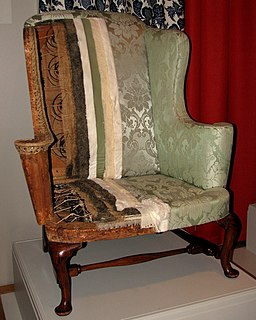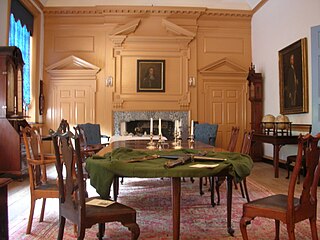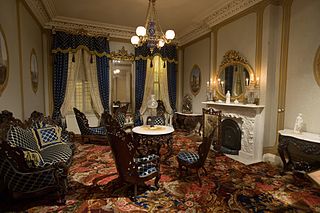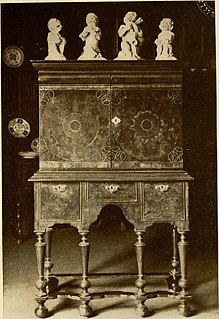
Waterfall is a style of furniture design from the 1930s and 1940s. It was the most prevalent variation on Art Deco furniture during this time, [1] primarily created for the mass market and for bedroom suites. [2] [3]

Waterfall is a style of furniture design from the 1930s and 1940s. It was the most prevalent variation on Art Deco furniture during this time, [1] primarily created for the mass market and for bedroom suites. [2] [3]
The style was distinguished by numerous features. It was named "Waterfall" due to its distinctive rounded drops at the edges of all horizontal surfaces, thought to resemble a flowing waterfall. Pieces in this style were usually finished with a blond veneer, though a small percentage were finished in a darker walnut finish. Drawer faces on more expensive Waterfall furniture often featured unusual designs such as decorative crossbanding and bookmatched panels. Handles were typically of orange Bakelite and brass, and some vanities had illuminated spheres or frosted panels. [1] Pieces in this style were sometimes paired with oversized round mirrors with etched trim. [1] The furniture was made with plywood, which would be molded during manufacturing. [3] Higher-quality pieces would feature the Waterfall curve in molded plywood where the plywood softened edges of side corners. Mass-produced Waterfall furniture often simply featured a quarter-round edge. [4]
Waterfall furniture contrasted from boxy walnut or mahogany pieces of the 1920s due to Waterfall's curved lines and its use of imported woods, including blond-colored Carpathian elm and golden padouk. [2]
The Waterfall style became popular in America after creating a stir at the Paris Colonial Exposition in 1931. A company in Grand Rapids, Michigan was among the first to produce furniture in the style in the United States; their efforts were successful enough to inspire other furniture factories to produce Waterfall furniture, much of which was mass-produced and of poor quality. [4]

Furniture refers to movable objects intended to support various human activities such as seating, eating (tables), storing items, eating and/or working with an item, and sleeping. Furniture is also used to hold objects at a convenient height for work, or to store things. Furniture can be a product of design and can be considered a form of decorative art. In addition to furniture's functional role, it can serve a symbolic or religious purpose. It can be made from a vast multitude of materials, including metal, plastic, and wood. Furniture can be made using a variety of woodworking joints which often reflects the local culture.

Plywood is a material manufactured from thin layers or "plies" of wood veneer that are glued together with adjacent layers having their wood grain rotated up to 90 degrees to one another. It is an engineered wood from the family of manufactured boards which include medium-density fibreboard (MDF), oriented strand board (OSB) and particle board (chipboard).

The fuselage is an aircraft's main body section. It holds crew, passengers, or cargo. In single-engine aircraft, it will usually contain an engine, as well, although in some amphibious aircraft the single engine is mounted on a pylon attached to the fuselage, which in turn is used as a floating hull. The fuselage also serves to position the control and stabilization surfaces in specific relationships to lifting surfaces, which is required for aircraft stability and maneuverability.

The Eastlake movement was a nineteenth-century architectural and household design reform movement started by British architect and writer Charles Eastlake (1836–1906). The movement is generally considered part of the late Victorian period in terms of broad antique furniture designations. In architecture the Eastlake style or Eastlake architecture is part of the Queen Anne style of Victorian architecture.

Engineered wood, also called mass timber, composite wood, man-made wood, or manufactured board, includes a range of derivative wood products which are manufactured by binding or fixing the strands, particles, fibres, or veneers or boards of wood, together with adhesives, or other methods of fixation to form composite material. The panels vary in size but can range upwards of 64 by 8 feet and in the case of cross-laminated timber (CLT) can be of any thickness from a few inches to 16 inches (410 mm) or more. These products are engineered to precise design specifications, which are tested to meet national or international standards and provide uniformity and predictability in their structural performance. Engineered wood products are used in a variety of applications, from home construction to commercial buildings to industrial products. The products can be used for joists and beams that replace steel in many building projects. The term mass timber describes a group of building materials that can replace concrete assemblies. Broad-base adoption of mass timber and their substitution for steel and concrete in new mid-rise construction projects over the next couple decades has the potential of turning timber buildings into a global carbon sink, which could help mitigate climate change.

Upholstery is the work of providing furniture, especially seats, with padding, springs, webbing, and fabric or leather covers. The word also refers to the materials used to upholster something.

Frame and panel construction, also called rail and stile, is a woodworking technique often used in the making of doors, wainscoting, and other decorative features for cabinets, furniture, and homes. The basic idea is to capture a 'floating' panel within a sturdy frame, as opposed to techniques used in making a slab solid wood cabinet door or drawer front, the door is constructed of several solid wood pieces running in a vertical or horizontal direction with exposed endgrains. Usually, the panel is not glued to the frame but is left to 'float' within it so that seasonal movement of the wood comprising the panel does not distort the frame.

Kitchen cabinets are the built-in furniture installed in many kitchens for storage of food, cooking equipment, and often silverware and dishes for table service. Appliances such as refrigerators, dishwashers, and ovens are often integrated into kitchen cabinetry. There are many options for cabinets available at present.

The Eames Lounge Chair and ottoman are furnishings made of molded plywood and leather, designed by Charles and Ray Eames for the Herman Miller furniture company. They are officially titled Eames Lounge (670) and Ottoman (671) and were released in 1956 after years of development by designers. It was the first chair that the Eameses designed for a high-end market. Examples of these furnishings are part of the permanent collection of New York's Museum of Modern Art.

In woodworking, veneer refers to thin slices of wood and sometimes bark, usually thinner than 3 mm, that typically are glued onto core panels to produce flat panels such as doors, tops and panels for cabinets, parquet floors and parts of furniture. They are also used in marquetry. Plywood consists of three or more layers of veneer. Normally, each is glued with its grain at right angles to adjacent layers for strength. Veneer beading is a thin layer of decorative edging placed around objects, such as jewelry boxes. Veneer is also used to replace decorative papers in Wood Veneer HPL. Veneer is also a type of manufactured board.
Brynmawr Furniture Makers Ltd was a furniture manufacturing company set up in the midst of the Great Depression in the United Kingdom as part of the Brynmawr Experiment in Brynmawr, Wales.

The "REX" Chair is a Slovenian wood chair design that is included in the collection of the Museum of Modern Art MOMA in New York City and was designed by Slovene architect and designer Niko Kralj (1920-2013) in 1952. In 2012, it was given a permanent place in Designmuseum, Denmark, the largest museum of design in Scandinavia. It became a cult object for design lovers around the globe with its calm contemporary elegance and a feeling of floating. It is the most internationally notable Slovenian design item and in 2004, at the 50 years anniversary of its development there was at the Museum of Modern Art in Ljubljana an exhibition devoted to the REX chair. REX chair was ranked at the second place as the Slovenian product of 20th century according to the ″Finance″ newspaper in 1999.

The Queen Anne style of furniture design developed before, during, and after the time of Queen Anne, who reigned from 1702 to 1714.

Charles Ormond Eames, Jr. (1907–1978) and Bernice Alexandra "Ray" Kaiser Eames (1912–1988) were an American married couple of industrial designers who made significant historical contributions to the development of modern architecture and furniture through the work of the Eames Office. They also worked in the fields of industrial and graphic design, fine art, and film. Charles was the public face of the Eames Office, but Ray and Charles worked together as creative partners and employed a diverse creative staff. Among their most recognized designs is the Eames Lounge Chair and the Eames Dining Chair.

Danish modern is a style of minimalist furniture and housewares from Denmark associated with the Danish design movement. In the 1920s, Kaare Klint embraced the principles of Bauhaus modernism in furniture design, creating clean, pure lines based on an understanding of classical furniture craftsmanship coupled with careful research into materials, proportions and the requirements of the human body. With designers such as Arne Jacobsen and Hans Wegner and associated cabinetmakers, Danish furniture thrived from the 1940s to the 1960s. Adopting mass-production techniques and concentrating on form rather than just function, Finn Juhl contributed to the style's success. Danish housewares adopting a similar minimalist design such as cutlery and trays of teak and stainless steel and dinnerware such as those produced in Denmark for Dansk in its early years, expanded the Danish modern aesthetic beyond furniture.

Thomas Day (1801–1861) was a free Black furniture craftsman and cabinetmaker in Milton, Caswell County, North Carolina. Born in Dinwiddie County, Virginia, Day moved to Milton in 1817 and became a highly successful businessman, boasting the largest and most productive workshop in the state during the 1850s. Day catered to upper-class white clientele and was respected among his peers for his craftsmanship and work ethic. Day came from a relatively well-off family and was privately educated. Today, Day's pieces are highly sought after and sell for high prices; his work has been heavily studied and displayed in museums such as the North Carolina Museum of History. Day is celebrated as a highly skilled craftsman and savvy businessman, specifically in regards to the challenges his race posed to his success in the Antebellum South.

The Rococo Revival style emerged in Second Empire France and then was adapted in England. Revival of the rococo style was seen all throughout Europe during the 19th century within a variety of artistic modes and expression including decorative objects of art, paintings, art prints, furniture, and interior design. In much of Europe and particularly in France, the original rococo was regarded as a national style, and to many, its reemergence recalled national tradition. Rococo revival epitomized grandeur and luxury in European style and was another expression of 19th century romanticism and the growing interest and fascination with natural landscape.

A cabinet is a case or cupboard with shelves and/or drawers for storing or displaying items. Some cabinets are stand alone while others are built in to a wall or are attached to it like a medicine cabinet. Cabinets are typically made of wood, coated steel, or synthetic materials. Commercial grade cabinets usually have a melamine-particleboard substrate and are covered in a high pressure decorative laminate, commonly referred to as Wilsonart or Formica.

Molded plywood is the term for two- or three-dimensionally shaped products from multiple veneer layers that are glued together through heat and pressure in a pressing tool. The veneer layers are arranged crosswise at an angle of 90 degrees. Molded wood is used for flat furniture components such as seats, backrests and seat shells. When the veneer layers are arranged in the same direction, it is called laminated wood. It is used for armrests and chair frames. After pressing, the blanks are processed mechanically. A particular feature is the ability to produce different variations of shapes from the blanks. Due to its immense strength and low weight, molded wood is particularly suitable for interior decoration, seating furniture, bed slats, skateboards and vehicle construction.

What later came to be known as the William and Mary style is a furniture design common from 1700 to 1725 in the Netherlands, the Kingdom of England, the Kingdom of Scotland, Kingdom of Ireland and later, in England's American colonies. It was a transitional style between Mannerist furniture and Queen Anne furniture. Sturdy, emphasizing both straight lines and curves, and featuring elaborate carving and woodturning, the style was one of the first to imitate Asian design elements such as japanning.